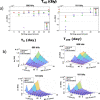Effect of Photoinitiators Doped in PDMS for Femtosecond-Laser Writing: Characterization and Outcomes
- PMID: 37720752
- PMCID: PMC10500646
- DOI: 10.1021/acsomega.3c01202
Effect of Photoinitiators Doped in PDMS for Femtosecond-Laser Writing: Characterization and Outcomes
Abstract
Herein, we have characterized in depth the effect of femtosecond (fs)-laser writing on various polydimethylsiloxane (PDMS)-based composites. The study combines systematic and nanoscale characterizations for the PDMS blends that include various photoinitiators (organic and inorganic agents) before and after fs-laser writing. The results exhibit that the photoinitiators can dictate the mechanical properties of the PDMS, in which Young's modulus of PDMS composites has higher elasticity. The study illustrates a major improvement in refractive index change by 15 times higher in the case of PDMS/BP-Ge [benzophenone (BP) allytriethylgermane] and Irgacure 184. Additional enhancement was achieved in the optical performance levels of the PDMS composites (the PDMS composites of Irgacure 184/500, BP-Ge, and Ge-ATEG have a relative difference of less than 5% in comparison with pristine PDMS), which are on par with glasses. This insightful study can guide future investigators in choosing photoinitiators for particular applications in photonics and polymer chemistry.
© 2023 The Authors. Published by American Chemical Society.
Conflict of interest statement
The authors declare no competing financial interest.
Figures









References
LinkOut - more resources
Full Text Sources

